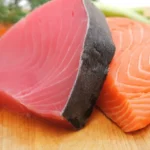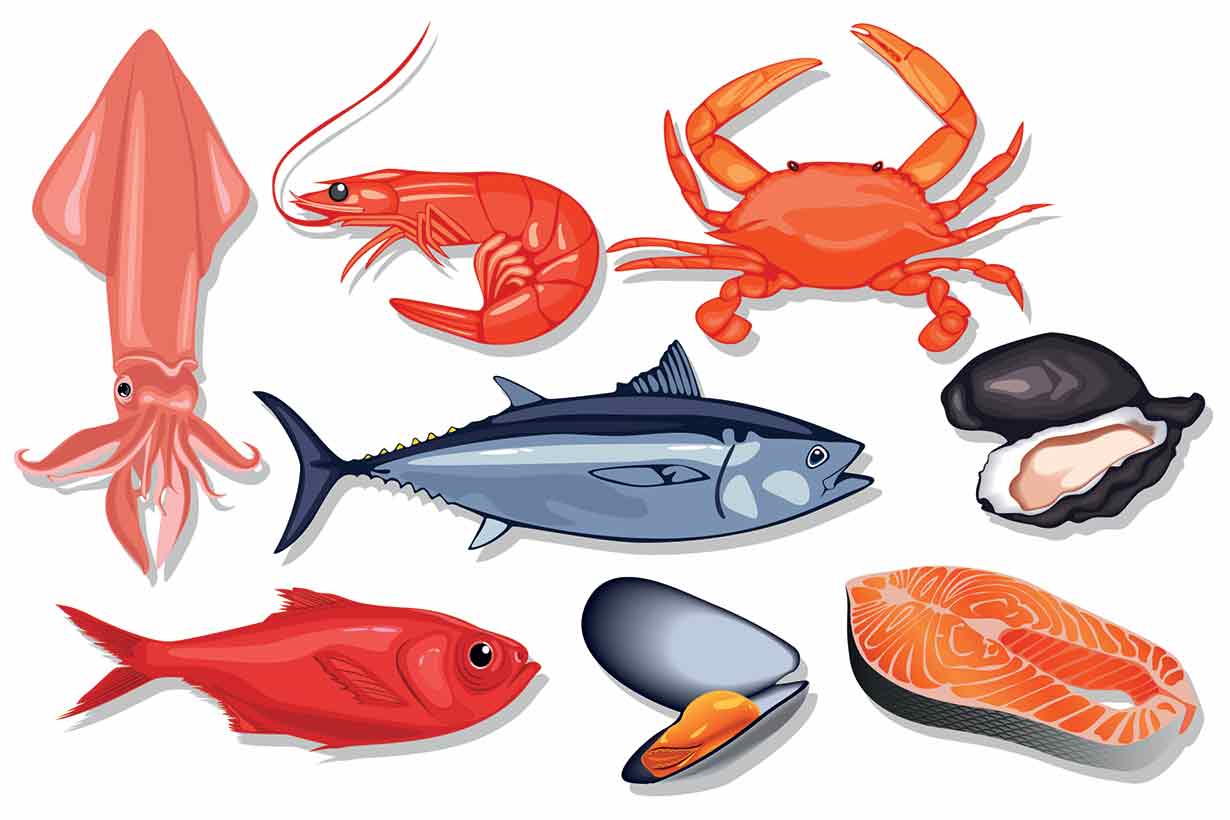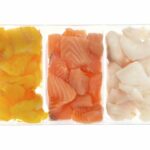Tuna is one of the most popular seafood options in the human diet.
However, there are several different types of tuna, each with its unique nutritional profile.
In this article, we’ll explore the main tuna varieties, their nutritional benefits, omega-3 content, mercury levels, and more.
Types of Tuna
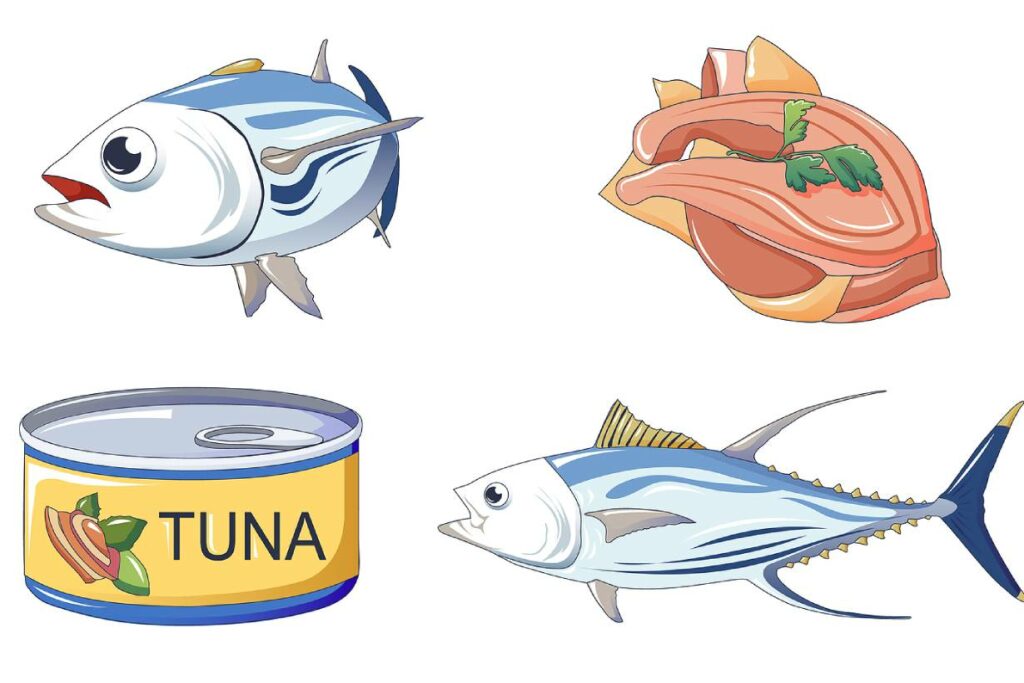
This guide will focus on the following tuna varieties and products:
- Albacore
- Bigeye
- Bluefin
- ‘Light’ canned tuna
- Skipjack
- ‘White’ canned tuna
- Yellowfin
For each variety, we’ll present their nutritional values, average mercury content, omega-3 levels, sustainability ratings, and additional relevant information. Moreover, we’ll highlight the vitamins and minerals present in high amounts for each fish, categorizing as anything exceeding 10% of the ‘daily value’.
Percent daily values (% DV) have been calculated using the U.S. Food & Drug Administration’s (FDA) daily values.
Sustainability ratings have been sourced from Monterey Bay Aquarium’s Seafood Watch.
1) Albacore Tuna
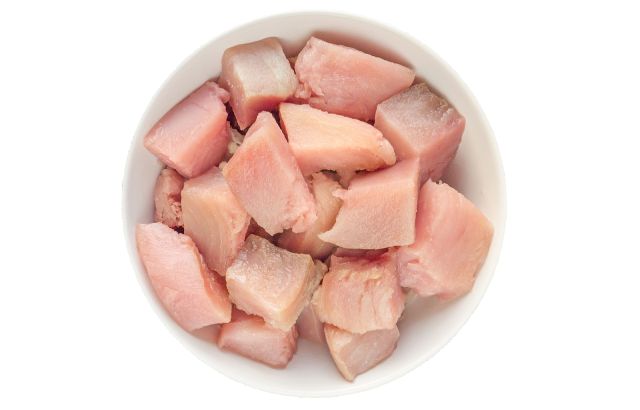
Albacore tuna, scientifically known as Thunnus alalunga, is also referred to as longfin tuna. You can find this large fish in both fresh and pre-cooked canned forms for commercial purchase (1).
Albacore tuna can reach an impressive size, growing to weights of 80 pounds (36 kg) and a length of 1.19 meters. This tuna species lives in temperate and tropical oceans around the world (2).
Nutritional Values
Based on data from the NCC Food and Nutrient Database, here is the nutritional profile of Albacore tuna per 100 grams when cooked (3).
| Name | Amount | % Daily Value |
|---|---|---|
| Calories | 128 kcal | |
| Carbohydrates | 0 g | 0% |
| Fiber | 0 g | 0% |
| Sugars | 0 g | |
| Fat | 2.97 g | 3.8% |
| Saturated | 0.79 g | 4.0% |
| Monounsaturated | 0.78 g | |
| Polyunsaturated | 1.11 g | |
| Omega-3 | 1.00 g | |
| Omega-6 | 0.07 g | |
| Protein | 23.62 g | 47.2% |
| Cholesterol | 42.0 mg | 14.0% |
| Sodium | 50.0 mg | 2.2% |
The table highlights that 100 grams of cooked albacore tuna provides a good amount of protein. Additionally, it is moderately high in omega-3, providing around one gram of these fatty acids.
It offers high levels of the following vitamins and minerals:
- Selenium: 65.70 mcg (119% DV)
- Vitamin B12: 1.17 mcg (49% DV)
- Niacin (B3): 5.80 mg (36% DV)
- Phosphorus: 217.0 mg (17% DV)
- Vitamin D: 2.0 mcg (13% DV)
- Vitamin B6: 0.22 mg (13% DV)
Mercury Content
The FDA’s monitoring program for mercury concentrations in fish has revealed that fresh albacore tuna, based on 43 samples, contains a mean mercury concentration of 0.358 parts per million (PPM) (4).
This mercury content translates to approximately 35.8 mcg of mercury per 100 grams of albacore tuna.
Later in this article, we will discuss the U.S. EPA’s ‘reference dose’ for mercury, which is dependent on body weight, to better understand these mercury content implications.
Sustainability
According to Monterey Bay Aquarium Seafood Watch, albacore tuna caught in the U.S Atlantic or Pacific Oceans are considered good, sustainable choices.
However, they issue a caution regarding albacore caught in the Indian Ocean, where albacore is flagged as being overfished and with ineffective management practices (5).
2) Bluefin Tuna
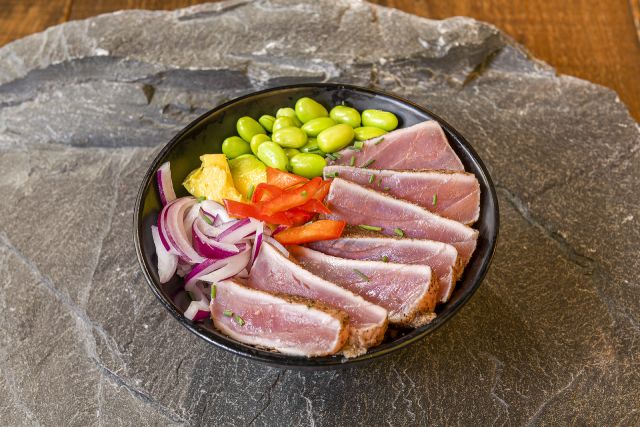
Bluefin tuna, scientifically known as Thunnus thynnus, is a fish of concern for overfishing (6).
Commercial bluefin tuna is available as fresh and canned fish, and it is viewed as a prized delicacy in Asia, for making sushi and sashimi (7).
The bluefin tuna is the largest species of tuna. It is a very large fish capable of reaching a surprising weight of 2000 pounds (909 kg) (8).
Nutritional Values
Based on data from the USDA’s FoodData Central database, here are the nutritional values for 100 grams of cooked bluefin tuna (9):
| Name | Amount | % Daily Value |
|---|---|---|
| Calories | 184 kcal | |
| Carbohydrates | 0 g | 0% |
| Fiber | 0 g | 0% |
| Sugars | 0 g | |
| Fat | 6.28 g | 8.1% |
| Saturated | 1.61 g | 8.1% |
| Monounsaturated | 2.05 g | |
| Polyunsaturated | 1.84 g | |
| Omega-3 | 1.66 g | |
| Omega-6 | 0.07 g | |
| Protein | 29.91 g | 59.8% |
| Cholesterol | 49.0 mg | 16.3% |
| Sodium | 50.0 mg | 2.2% |
As indicated in the table, bluefin tuna boasts a high protein content and provides a substantial amount of omega-3 fatty acids, totaling 1.66 grams.
Bluefin tuna also provides good amounts of the following vitamins and minerals:
- Vitamin B12: 10.88 mcg (453% DV)
- Selenium: 46.80 mcg (85% DV)
- Vitamin A: 757 mcg RAE (84% DV)
- Niacin (B3): 10.54 mg (66% DV)
- Vitamin B6: 0.53 mg (31% DV)
- Pantothenic acid (B5): 1.37 mg (27% DV)
- Phosphorus: 326.0 mg (26% DV)
- Thiamin (B1): 0.28 mg (23% DV)
- Riboflavin (B2): 0.31 mg (24% DV)
- Magnesium: 64.0 mg (15% DV)
Mercury Content
Research findings indicate that farmed bluefin tuna contained 60 mcg of mercury per 100 grams.
However, wild Atlantic bluefin tuna showed higher mercury levels of 170 mcg per 100 grams (10).
To put it simply, the mercury levels in bluefin tuna are very high.
Sustainability
Monterey Bay Aquarium’s Seafood Watch advises avoiding all bluefin tuna since it is overfished or depleted (5).
In other words, it is unsustainable to continue consuming bluefin tuna at current rates.
3) Bigeye Tuna
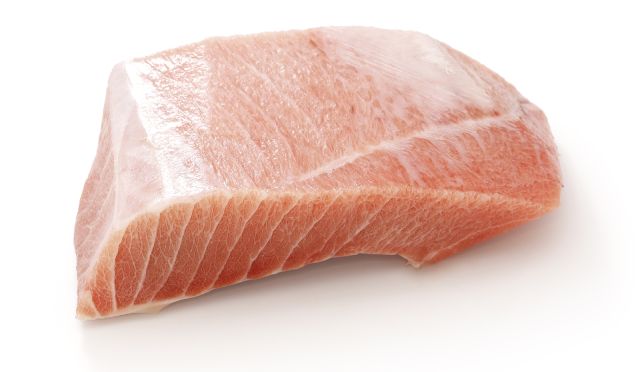
Bigeye tuna, scientifically known as Thunnus obesus, can be found in temperate and tropical waters aside from the Mediterranean (11).
This tuna species ranks as one of the largest in size. Bigeye tuna can grow as long as 180 cm and as heavy as 210 kg (11).
Beyond being a popular fish for making sashimi, bigeye tuna is available fresh and frozen (12).
Nutritional Values
Based on Trustwell nutrition data, here are the nutritional values for 100 grams of cooked bigeye tuna (13).
Unfortunately, no ‘cooked’ data for bigeye tuna is available, so these are the raw values.
| Name | Amount | % Daily Value |
|---|---|---|
| Calories | 115 kcal | |
| Carbohydrates | 0 g | |
| Fiber | 0 g | |
| Sugars | 0 g | |
| Fat | 1.76 g | 2.3% |
| Saturated | 0.44 g | 2.2% |
| Monounsaturated | 0.44 g | |
| Polyunsaturated | 0.44 g | |
| Omega-3 | 0.44 g | |
| Omega-6 | – | |
| Protein | 23.81 g | 47.6% |
| Cholesterol | 39.68 mg | 13.2% |
| Sodium | 61.73 mg | 2.7% |
As shown in the table, bigeye tuna is low in fat and calories while being a rich protein source.
Additionally, it contains these vitamins and minerals in high concentrations:
- Selenium: 98.77 mcg (180% DV)
- Niacin (B3): 17.64 mg (110% DV)
- Vitamin B12: 2.12 mcg (88% DV)
- Vitamin B6: 0.62 mg (36% DV)
- Phosphorus: 176.37 mg (14% DV)
Mercury Content
Based on data from the FDA’s mercury in fish monitoring program, 21 samples of bigeye tuna contained a mean mercury content of 0.689 PPM (4).
This mercury content equates to a mercury level of 68.9 mcg per 100 grams of bigeye tuna.
Sustainability
According to Monterey Bay Seafood Watch, bigeye tuna is overfished in the Atlantic and Indian Oceans. However, they state bigeye tuna from the Pacific Ocean is a more sustainable choice (5).
Their other recommendations include:
- Buying Atlantic or Pacific bigeye tuna caught by U.S. fisheries using either pole-&-lines or trolling lines.
- Purchasing bigeye tuna caught by drifting longlines in the Pacific Ocean.
4) ‘Light’ Canned Tuna
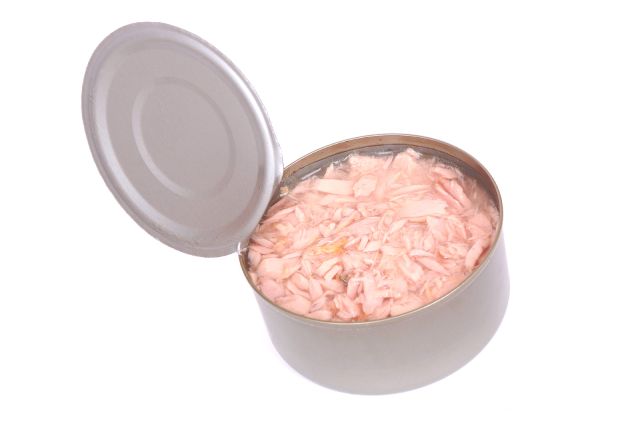
‘Light’ canned tuna has a light pink-ish color, setting it apart from ‘white’ canned tuna. Although it can vary, light tuna tends to comprise of smaller tuna species like skipjack and yellowfin.
Notably, light canned tuna offers greater affordability compared to fresh tuna, and it’s a convenient option due to being precooked before canning.
For culinary purposes, light tuna is a versatile ingredient that works well in pasta dishes, salads, sandwiches, soups, and stews.
Nutritional Values
Based on USDA nutrition data, here is the nutritional profile for 100 grams of ‘light’ canned tuna (14).
The values are specifically for light tuna ‘canned in water’ – note that ‘canned in oil’ options will provide higher amounts of fat and total calories.
| Name | Amount | % Daily Value |
|---|---|---|
| Calories | 116 kcal | |
| Carbohydrates | 0 g | 0% |
| Fiber | 0 g | 0% |
| Sugars | 0 g | |
| Fat | 0.82 g | 1.1% |
| Saturated | 0.23 g | 1.2% |
| Monounsaturated | 0.03 g | |
| Polyunsaturated | 0.34 g | |
| Omega-3 | 0.28 g | |
| Omega-6 | <0.01 g | |
| Protein | 25.5 g | 51% |
| Cholesterol | 30 mg | 10% |
| Sodium | 50 mg | 2.2% |
As the data demonstrates, ‘light’ canned tuna is low in calories and relatively high in protein, making it a nutritious option.
It also provides high levels of these vitamins and minerals:
- Selenium: 80.40 mcg (146% DV)
- Vitamin B12: 2.99 mcg (125% DV)
- Niacin (B3): 13.3 mg (83% DV)
- Vitamin B6: 0.35 mg (21% DV)
- Phosphorus: 163.0 mg (13% DV)
Mercury Content
According to data from 145 samples in the FDA’s mercury monitoring program, canned ‘light’ tuna showed a mean mercury content of 0.126 PPM (4).
This is the equivalent of 12.6 mcg of mercury per 100 grams.
Sustainability
According to Monterey Bay Seafood Watch, when purchasing canned tuna, look for products labeled as either (5):
- Pole-caught
- Pole-&-line caught
- Troll-caught
- FAD-free
- Free school
- School-caught
Seafood Watch also advises avoiding tuna caught in the Indian Ocean.
5) Skipjack Tuna

Skipjack tuna, scientifically known as Katsuwonus pelamis, is one of the smaller types of tuna. The fish primarily inhabits the tropical waters of the Atlantic, Indian, and Pacific Oceans (15).
The skipjack tuna can grow to a size of approximately 40 pounds (18kg) and 0.91 meters (15).
Nutritional Values
Based on USDA data, here are the nutritional properties of cooked skipjack tuna per 100 grams (16):
| Name | Amount | % Daily Value |
|---|---|---|
| Calories | 132 kcal | |
| Carbohydrates | 0 g | 0% |
| Fiber | 0 g | 0% |
| Sugars | 0 g | |
| Fat | 1.29 g | 1.7% |
| Saturated | 0.42 g | 2.1% |
| Monounsaturated | 0.24 g | |
| Polyunsaturated | 0.40 g | |
| Omega-3 | 0.35 g | |
| Omega-6 | 0.02 g | |
| Protein | 28.21 g | 56.4% |
| Cholesterol | 60.0 mg | 20% |
| Sodium | 47.0 mg | 2.0% |
The data shows us that skipjack tuna is a protein-rich and low-calorie tuna variety.
Here are the vitamins and minerals it provides in generous quantities:
- Selenium: 46.80 mcg (85% DV)
- Phosphorus: 285 mg (23% DV)
- Potassium: 522 mg (11% DV)
- Magnesium: 44.0 mg (10% DV)
- Niacin (B3): 18.8 mg (117% DV)
- Vitamin B6: 0.98 mg (58% DV)
- Vitamin B12: 2.19 mcg (91% DV)
Mercury Content
According to the FDA’s mercury in fish monitoring program, skipjack tuna ranks as one of the lowest-mercury tuna varieties. Based on three samples, skipjack had a mean mercury concentration of 0.144 PPM (4).
0.144 PPM translates to 14.4 mcg of mercury per 100 grams.
Sustainability
Monterey Bay Seafood Watch suggests avoiding skipjack tuna from the Indian Ocean due to concerns about ineffective management and bycatch problems.
For a more sustainable option, they advise buying US skipjack tuna caught in the Atlantic or Pacific caught using fishing methods such as trolling lines, pole-&-lines, or purse seines that don’t use FADs (fish aggregating devices) (5).
6) ‘White’ Canned Tuna
Unlike light tuna, canned ‘white’ tuna comes from a large species of tuna called albacore.
White canned tuna has a whiter flesh color and a higher fat content than light canned tuna.
Consequently, white canned tuna provides a richer source of omega-3 fatty acids, but at a higher expense.
It is
Nutritional Values
Below is the nutritional profile of white canned tuna, canned in water, presented per 100 grams. The data source is the USDA’s FoodData Central (17).
| Name | Amount | % Daily Value |
|---|---|---|
| Calories | 128 kcal | |
| Carbohydrates | 0 g | 0% |
| Fiber | 0 g | 0% |
| Sugars | 0 g | |
| Fat | 2.97 g | 3.8% |
| Saturated | 0.79 g | 4.0% |
| Monounsaturated | 0.78 g | |
| Polyunsaturated | 1.11 g | |
| Omega-3 | 0.95 g | |
| Omega-6 | 0.06 g | |
| Protein | 23.62 g | 47.2% |
| Cholesterol | 42.0 mg | 14% |
| Sodium | 50.0 mg | 2.2% |
As we can see from these nutrient values, it is evident that white canned tuna has higher levels of fat and omega-3 but relatively less protein compared to light tuna.
Furthermore, it provides these vitamins and minerals in high levels:
- Selenium: 65.70 mcg (119% DV)
- Vitamin B12: 1.17 mcg (49% DV)
- Niacin (B3): 5.80 mg (36% DV)
- Phosphorus: 217.0 mcg (17% DV)
- Vitamin B6: 0.22 mg (13% DV)
For those interested in how white tuna compares to canned salmon for omega-3, see this nutritional comparison of salmon and tuna.
Mercury Content
According to the FDA’s mercury in fish monitoring program, based on 144 samples, canned white (albacore) tuna displayed an average mercury concentration of 0.350 PPM (4).
This mercury content is equal to 35 mcg per 100 grams.
Sustainability
Monterey Bay Seafood Watch offers consistent recommendations for all canned tuna, so their advice for light canned tuna equally applies to white canned tuna.
An additional point they emphasize is the importance of looking out for canned tuna products that follow sustainable seafood policies, such as those available at Whole Foods Market (5).
7) Yellowfin Tuna
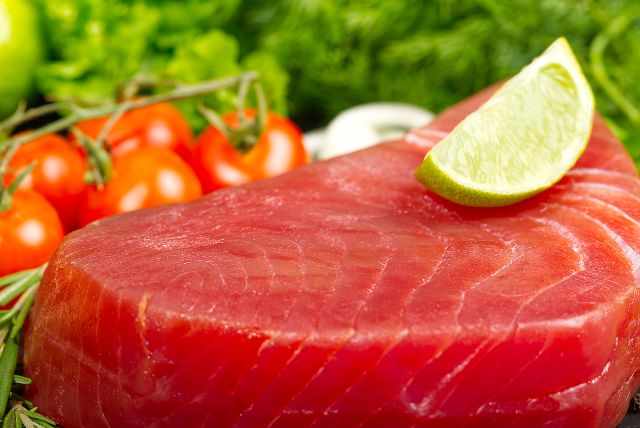
Yellowfin tuna has the scientific name Thunnus albacares, and it is one of the largest tuna species. In this regard, yellowfin can reach weights of 450 pounds (204 kg) and lengths of 2.1 meters (18).
Among its culinary uses, yellowfin is usually cooked fresh and served as a ‘steak.’
However, it is also a type of tuna used for canned tuna and making sushi and sashimi (19).
Nutritional Values
Here are the nutritional values for cooked yellowfin tuna per 100 grams, sourced from USDA nutrition data (20):
| Name | Amount | % Daily Value |
|---|---|---|
| Calories | 130 kcal | |
| Carbohydrates | 0 g | 0% |
| Fiber | 0 g | 0% |
| Sugars | 0 g | |
| Fat | 0.59 g | 0.8% |
| Saturated | 0.21 g | 1.1% |
| Monounsaturated | 0.14 g | |
| Polyunsaturated | 0.18 g | |
| Omega-3 | 0.13 g | |
| Omega-6 | 0.03 g | |
| Protein | 29.2 g | 58.4% |
| Cholesterol | 47 mg | 15.7% |
| Sodium | 54 mg | 2.3% |
As the nutritional values demonstrate, yellowfin tuna is one of the leanest types of tuna. It has a significant protein content and a modest amount of dietary fat.
Furthermore, yellowfin tuna is high in these vitamins and minerals:
- Selenium: 108.20 mcg (197% DV)
- Niacin (B3): 22.07 mg (138% DV)
- Vitamin B12: 2.35 mcg (98% DV)
- Vitamin B6: 1.04 mg (61% DV)
- Phosphorus: 333 mg (27% DV)
- Vitamin D: 2.1 mcg (14% DV)
- Potassium: 527 mg (11% DV)
- Magnesium: 42 mg (10% DV)
Mercury Content
According to the FDA’s mercury in fish monitoring program, yellowfin tuna exhibits a mean mercury content of 0.354 PPM. This average figure is based on 231 samples (4).
0.354 PPM corresponds to 35.4 mcg of mercury per 100 grams.
Sustainability
Monterey Bay Seafood Watch provides sustainability recommendations for yellowfish tuna as follows (5):
- Yellowfin tuna stocks in the Atlantic and Pacific Oceans are healthy.
- Overfishing and bycatch issues are a problem with yellowfin tuna in the Indian Ocean.
- The most favorable options are yellowfin tuna caught with pole-&-lines, trolling lines, or purse seines without FADs.
Why Is the Mercury Content of Tuna Important?
The reason to be aware of mercury in tuna is because it’s a heavy metal capable of causing toxic effects within the body.
These potential adverse effects encompass problems related to the nervous system, cognitive and developmental issues in children, and potential neurological complications. Research also points to high mercury levels having adverse effects on the cardiovascular and immune systems (21, 22, 23, 24).
Additionally, a systematic review published in 2022 examined the impact of mercury intake during pregnancy. This study found that prenatal mercury exposure was associated with lower birth weight. Furthermore, children with higher prenatal mercury exposure obtained lower scores on developmental tests as children (25).
Since mercury can progressively build up in the body over time through frequent consumption of high-mercury fish, it is crucial to limit mercury-rich options.
What is the U.S. EPA’s ‘Reference Dose’ For Mercury?
Drawing from toxicological studies investigating mercury’s impact on human health and large bodies of research on the subject, the United States Environmental Protection Agency (EPA) has set a ‘reference dose’ for mercury intake.
This dose represents the daily intake level deemed to pose no appreciable health risk over a lifetime. The EPA has set the reference dose for mercury exposure at 0.1 mcg per kilogram of body weight per day (26, 27).
In other words, for an individual weighing 70 kilograms, the reference dose would be as follows:
70 kg x 0.1 mcg = 7 mcg per day
This would change to 8 mcg per day for an individual weighing 80 kilograms, 6 mcg for a weight of 60 kilograms, and so forth.
Now that we know the maximum amount of mercury recommended for consumption, let’s revisit the mercury content of the different tuna types:
- Albacore tuna: 35.8 mcg mercury per 100 grams
- Bigeye tuna: 68.9 mcg per 100 grams
- Bluefin tuna: 60-170 mcg per 100 grams
- Light canned tuna: 12.6 mcg per 100 grams
- Skipjack tuna: 14.4 mcg per 100 grams
- White canned tuna: 35 mcg per 100 grams
- Yellowfin tuna: 35.4 mcg per 100 grams
This demonstrates that, for most individuals, every tuna variety exceeds the reference dose for mercury intake.
As a result, it is easy to understand why recommendations state that we should consume tuna in moderation.
How Much Tuna Should We Consume?
Based on the mercury content of fish, the FDA and EPA have published joint advice for fish intake. This advice is aimed at children and pregnant women and states that (28):
- Light canned tuna and skipjack tuna are considered the ‘best choices’ and can be consumed at 2-3 servings per week. A ‘serving’ is classed as 4 ounces (113 grams) for women. For children, a ‘serving’ is one ounce (28.35g) at 1-3 years old, two ounces at age 4-7, three ounces at age 8-10, and four ounces at age 11 and above.
- Albacore, canned white tuna, and yellowfin are considered ‘good choices’ and can be consumed as one serving per week.
- Bigeye tuna is categorized as a ‘choice to avoid’ due to its highest mercury levels.
The Dietary Guidelines for Americans 2020-2025 provide simpler advice, recommending that people consume at least eight ounces (227 grams) of seafood per week, based on a 2000-calorie diet (29).
For those seeking lower-mercury seafood options, this list of oily fish offers some good options.
Additionally, smaller fish options like anchovies, sardines, and sprats are known for having the lowest mercury content.
A Note On Sustainability
In addition to the general sustainability recommendations presented for each type of tuna, the Marine Steward Council’s (MSC) certification is something to look out for.
On this note, any seafood product bearing the blue MSC label has met stringent requirements for sustainable fishing.
Questions About the Different Types of Tuna
Lastly, to answer any potentially outstanding queries, here are some answers to common questions about tuna.
According to USDA nutritional data, bluefin, skipjack, and yellowfin are the most protein-rich tuna varieties.
Bluefin tuna has the highest omega-3 content, with 1.66 grams per 100 grams of fish. Albacore and white canned tuna are also high in omega-3.
Tuna is a rich source of protein and has a moderate to high level of omega-3, depending on the variety. It is also an excellent source of vitamins and minerals, particularly B vitamins and selenium.
Tuna has an excellent nutritional profile and provides a broad range of essential nutrients. However, it tends to contain more mercury than other commonly consumed seafood options. In moderation, tuna can fit into a healthy dietary pattern, but it is important to be aware of overall mercury intake.
Final Thoughts
As this article shows, there are numerous types of tuna, and they all differ nutritionally.
Most of these tuna varieties can fit into a good diet, and the ‘best choice’ will be a combination of personal preference and nutritional goals.
However, it is worth bearing in mind that bigeye and bluefin tuna have a significantly higher mercury content than the other varieties.


